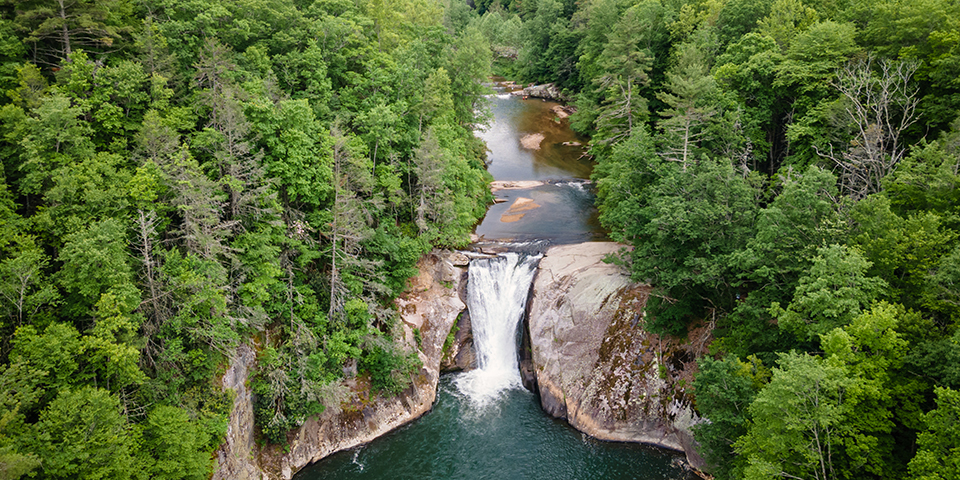NORTH CAROLINA
These five North Carolina destinations cover the gamut from quirky towns to epic mountain ranges. Plan a North Carolina trip from coastal plains to rugged highlands.
Asheville
Nestled among the Great Smoky Mountains, Asheville is known as “the San Francisco of the East” for its artistic vibe, diverse communities and decadent craft brews. This is home to the largest mansion in the U.S., the third oldest river in the world, two downtown history trails, and a thriving craft beer industry. Take a leisurely drive along America’s longest linear park — the Blue Ridge Parkway — and gaze upon some of the oldest mountains on earth. And if you like the Bohemian side of life, Asheville hums with offbeat charm. You’ll find several galleries and music venues in town.
America’s Downton Abbey
Biltmore Estate is the largest privately owned house in the United States. Comprised of more than 8,000 acres, the home touts 250 rooms including 35 bedrooms, 43 bathrooms, a 10,000-volume library and 65 fireplaces. Take the regular house tour but don’t miss some of the behind-the-scene offerings like the Rooftop Tour with spectacular views. The Butler’s Tour shares a backstairs glimpse at the 19th century bachelors’ quarters, and the Home Within a Home Tour showcases how Mrs. Vanderbilt created a cozy abode inside those vast mansion walls. Visit the Farm at Antler Hill Village, a working farmstead with shops, eateries and an award-winning winery.
Exploring a Timeless River
The French Broad River is the third oldest tributary in the world with a meandering route that helped to shape the Appalachian Mountains. Flowing south to north, the river is an ideal spot for recreation seekers. Soak up some rays as you kayak, bellyak, paddleboard and canoe its tranquil water. Set up camp along the banks and take time to bird-watch, fly-fish and explore the wilderness areas.
Hit the Downtown Trails
The Downtown Urban Trail provides a two-hour walking tour past several of Asheville’s historical spots. View the largest self-supporting elliptical dome in North America, the basilica of St. Lawrence, and take a stroll through The Market, a nod back to the time when produce stands and livery stables were plentiful. Ramble along the Architectural Trail and see a dozen renowned buildings from the early 1900s, when Asheville was becoming “The Miami of the Mountains.” Cycle out to explore historic neighborhoods, scenic back roads and a growing number of city greenways.
Tasty Brews
Today more than two-dozen breweries, brewpubs and cider companies call Asheville home. Check out Burial Beer Company for brew styles resurrected from Europe. Wicked Weed Brewing is the first sour tap room in the South. And Green Man Brewery makes legendary beers even their mythical namesake might want to quaff. While you’re out on the town, enjoy Asheville’s many entertainment options, from independent music to nouveau cuisine.
Regional Recipe
Apple Pie
Nothing says “wholesome” quite like apple pie. This time-honored recipe pumps up that sweet apple pie flavor. Recipe by the Good Sam Team.

getty images
Ingredients:
- Enough apples for pie (5½ – 6 cups of thinly sliced, peeled apples)
- 1 cup sugar
- 2 tbsp flour
- ½ tsp cinnamon
Directions:
Sprinkle nutmeg on top of apples & chunks of butter on apples. Place 1 pie crust in ungreased glass pie plate. Pour apples and mixture in pie dish. Put layer of crust on top. Brush top with cream or milk. Cook at 425 degress for 45 minutes or
until crust is golden brown.
Natural Waterslide
When summer hits, locals cool off by riding down the chilly waters of Sliding Rock in Pisgah National Forest. The 55- to 60-degree water makes for a refreshing time. Plus, many waterfalls are located nearby, including Looking Glass Falls. If you’re seeking something a bit more extreme, take a canyoneering trip with Green River Adventures and rappel down Bradley Falls, deep in the Green River Gorge. After learning the fundamentals of rappelling, take a practice run on a 30-foot vertical wall before you tackle the 200-foot descent. Certified guides guide you all the way.
Leisure Cruising
If you prefer a trip down the river without working up a sweat, take a cruise. French Broad Boatworks will take you on a guided scenic tour down the river in a locally crafted wooden drift boat, complete with your personal paddler. In addition to sunrise and sunset tours, there’s a birding trip and the River Arts District Tour that concludes with dinner and drinks at the riverside Smoky Park Supper Club.
Fun Among the Trees
The Adventure Center of Asheville offers adrenaline pumping adventures high above the ground, just five minutes from downtown. Get an eyeful of expansive views of the Asheville skyline from Asheville Zipline Canopy Adventures or hop on one of the top-end mountain bikes and cruise down thrilling trails. The on-site trail system was created and groomed for the KOLO Bike Park. If you prefer climbing to riding, head up into the trees at Asheville Treetops Adventure Park, an elevated obstacle course with five levels of difficulty. For little ones, the KidZip is America’s first zipline adventure designed for children under 10.
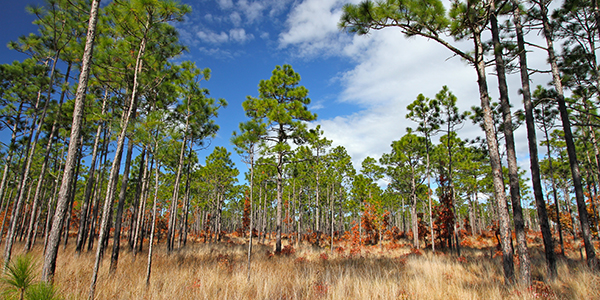
Longleaf pines in the Croatan National Forest, North Carolina
Seeing Grandpa
Located northeast of Asheville, Grandfather Mountain is one of the most popular ecotourism adventures in the state. Considered one of the most biologically diverse mountains on the planet, the mountain has been designated by the United Nations as an International Biosphere Reserve. For explorers, the mountain is worthy side trip from Asheville. Visitors will feel a genuine rush as they cross the Mile High Swinging Bridge, located one mile above sea level and dishing out 360-degree views. Photographers will catch sight of bears, otters, cougars, eagles and deer in natural habitats. Hikers can tackle rugged back-country trails or stroll gentle nature paths. The onsite restaurant and many scenic picnic areas help you refuel.
Botony on Display
A carefully tended wilderness preserve, Grandfather Mountain is home to many rare North American wildflowers, with displays of such naturalized plants as native azaleas, rhododendrons, mosses and lichens, heathers and other beautiful species. Parts of the mountain are steep and rocky, but much is accessible to anyone seeking dramatic mountain vistas and wildlife habitat areas.
Reach New Heights on Mount Mitchell
Eager to hike in high altitudes? From Asheville, travel 28 miles north on the Blue Ridge Parkway to Mount Mitchell State Park. At 6,684 feet, the namesake mountain tops every other summit east of the Mississippi River. Start your visit at the museum, open from May through October. Here, you can learn about the mountain’s natural and cultural history, including the effort by scholar Elisha Mitchell in the 1850s to prove the peak’s standing as the tallest.
Black Mountain Chain
Significantly, Mount Mitchell is only slightly taller than its sister summits along the chain of peaks known as the Black Mountains. In all, the lofty ridge includes six of the 10 highest peaks in the Eastern U.S. To walk along the trail connecting them is an exploration through eons of ecological and geological forces contributing to an uncanny diversity of life. What may not be obvious at first glance, concealed below the lush green canopy of the Southern Appalachians is a staggering assortment of life unparalleled in North America outside of the tropics.
Pointing to Pisgah
Head southeast of Asheville for even more mountain adventures. The Pisgah National Forest, established in 1916 and the first in the East, takes its name from the 5,722 foot Mount Pisgah southwest of Asheville and perhaps the city’s most recognizable summit. Its distinctive conical apex is topped with a TV tower. A popular 1.5-mile trail leads the summit from a parking area on the Blue Ridge Parkway. Also popular is the Black Balsam Knob, a summit in Pisgah with equally dazzling views.
Outer Banks and Cape Hatteras
A slender arc of barrier islands, known as the Outer Banks, shield the Atlantic shore of North Carolina. The isles are synonymous with the wild horses that run free along sandy shores or historic lighthouses standing guard above pristine beaches. Whether you seek relaxation or recreation, you can find it in the Outer Banks.
Beating it to the Banks
To the west of the Outer Banks, a string of sounds separate the islands from the mainland of North Carolina. To the east, you’ll find the endless waters of the Atlantic. Most travelers driving to the Outer Banks take U.S. Route 64 or U.S. Route 158 to North Carolina Highway 12, which connects at the northern end of the islands. Visiting the southern end requires a trip on a ferry. A number of small towns line the islands, including Corolla, Nags Head, Hatteras and Ocracoke.
Atlantic Sport Fishing
Fisherman flock to the region for the opportunity to throw in a line off one of the many piers or to join a chartered vessel for deep-sea fishing. Whether you fish in the sound, in the surf or offshore, you can angle for a variety of species. Not into lines and hooks? Paddlers will find a wide range of waterways to explore. The calm waters of the sounds invite those seeking tranquility and the chance to observe wildlife, while the ocean beckons to those seeking thrills in the surf. The banks’ waterways also are popular waterfowl hunting grounds. For a quintessential Outer Banks experience, take a trail to explore towering sand dunes. Adventure-seekers can surf, sail or explore the beaches on horseback or ATV.
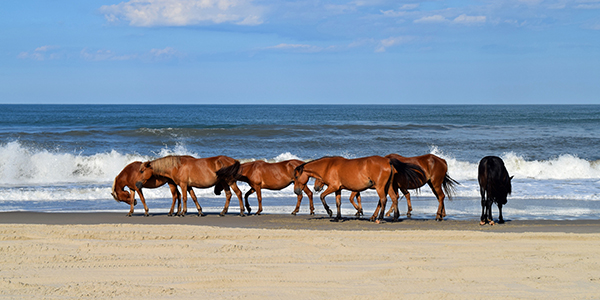
A harem of wild Colonial Spanish Mustangs (black stallion, six mares) roams freely along a beach in the Outer Banks of North Carolina.
Classic Light
At Cape Hatteras National Seashore, the iconic black-and-white Cape Hatteras Lighthouse stands guard over a dangerous section of the Atlantic. Climb the 257 steps to the top for epic views. Along the Outer Banks, diverse wildlife can be spotted, from resting seals to nesting sea turtles. Set sail on a cruise to watch for dolphins as a colorful sunset fills the skies. Back on land, the small towns of the Outer Banks welcome visitors with a plethora of shopping, entertainment and restaurant options.
Jockey’s Ridge State Park
Boasting the tallest natural sand dune system in the eastern United States, Jockey’s Ridge State Park, located in Nags Head, is famed for its sunset vistas. A fine preamble to the ritual is to take the moderate self-guided trail which stretches for 1.5 miles from the park’s parking lot across the dunes and back. If you’d prefer to skip the sand-in-your-toes experience, you can stroll the length of the 384-foot boardwalk instead. At the soundside access, on the southwest corner of the park, conditions are prime for kayaking, windsurfing and swimming. For more high-flying adventures, Jockey’s Ridge is hailed as one of the nation’s top hang-gliding destinations.
The Wright Stuff
Soar into the skies with a stop at the Wright Brothers National Memorial, which commemorates the pioneering siblings’ experiments with flight on Kitty Hawk’s Kill Devil Hills. It was here on the morning of December 17, 1903, that Orville and Wilbur Wright recorded the world’s first controlled powered flight, covering 120 feet in just under 12 seconds.
The Piedmont
The Piedmont region of North Carolina is synonymous with NASCAR, golfing and great barbecue. Throttle up adventure at the Charlotte Motor Speedway or hit the legendary greens of Pinehurst. Snowbirds will find the state’s largest cities and college towns overflowing with museums, cultural attractions, and historic sites. Outdoor adventure abounds in the rolling landscape, with rivers to paddle and mountain trails to explore on foot, wheel or horseback. Hanging Rock State Park, known for its amazing rock formations and stunning fall colors, is at the heart of it all. Join in the great North Carolina barbecue debate by sampling the famous Lexington-style pulled pork and red slaw.
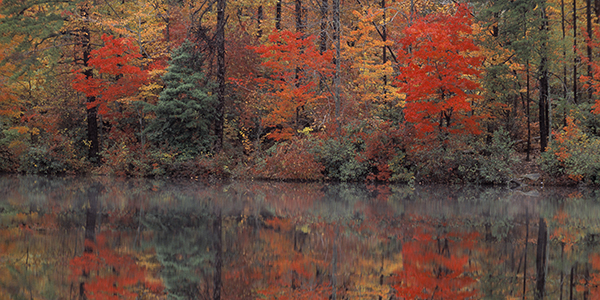
Queen City
A great place to start your Piedmont travels is Charlotte, an elegant city known for outstanding restaurants and great cultural attractions. It’s also home to an NFL team and several NASCAR-related attractions.
Life in the Colonial Era
In the 1700s, colonists named the town after Charlotte of Mecklenburg-Strelitz, queen consort to British King George III. Charlotte Museum of History is home to the 5,000-foot Hezekiah Alexander Rock House. Built in 1774, it’s the oldest remaining building in Mecklenburg County. On the eve of the American Revolution, local backcountry farmers calling themselves “Regulators” took arms against the Loyalist militia at Alamance Battleground near Burlington. Battle reenactments along with infantry and artillery drills are held regularly.
Charlotte Culture
Nowhere does Charlotte wear its modernity on its streets like its resident museums. The Levine Center for the Arts on Tryon Street includes the Bechtler Museum of Modern Art, and the Mint Museum reflects more than seven decades of art collecting. Discovery Place, with its aquarium and science demonstrations, will captivate children, and the organization also operates the Charlotte Nature Museum with its enchanting butterfly pavilion.
NASCAR Legacy
Charlotte sits in the heart of Cabarrus County, which lives up to its billing as the place “Where Racing Lives.” Home to legendary Charlotte Motor Speedway, zMAX Dragway and Kannapolis, the region also is hometown of driver Dale Earnhardt Sr., so it’s easy to see why NASCAR fans head to the area on more than just race days. Visitors can tour the NASCAR Hall of Fame in Charlotte to see how the sport evolved from informal stock car competitions to the billion-dollar juggernaut that it is today. Interactive exhibits give visitors a chance to experience the thrill of high-speed racing. Visit nearby NASCAR team shops to stock up on memorabilia and glean insights into the inner workings of top NASCAR comptetitors.
Petty Experience
Visitors can get a real taste of racing action with the Richard Petty Driving Experience at Charlotte Motor Speedway. Slip behind the wheel of a 600 horsepower stock car or ride-along with a professional driver at speeds up to 160 mph around the 1.5-mile steep-banked oval. For spectators, the motorsports complex hosts all manner of racing competitions through the year, headlined by the Coca-Cola 600 on Memorial Day.
Charlotte Pigskins
Are you ready for some football? When it’s game time, head to Bank of America Stadium for fun with fellow fans. The Carolina Panthers NFL Team is young by league standards — founded in 1995 — but they hold on to age-old feasting traditions. Tailgaters can choose a regular space as low as $11 or get a premium tailgating site for more than $100. RV parking is available at Cedar Yard Station, located immediately east of the Interstate 77 and Morehead Street interchange.
Tantalizing Tailgate Treat
Seeking inspiration for tailgating? The Pantherfanz Tailgating club has made a fine art of whipping up snacks for game day. Carolina Panthers fan and club member Dan “12th Man” Ortel proudly shared his sizzling 12th Man Hot Wings recipe. This dish serves as the perfect appetizer.
Charlotte Plant Life
Follow the paths that lead to colorful gardens at the University of North Carolina Charlotte Botanical Gardens, a purposeful collection of plants grown for more than just their beauty. Holding curated collections of plants for inventory, education, conservation and research, they are dedicated to sharing the world of plants with people. This is also a great place to learn about planting techniques for home gardeners.
Cast a Line
The Piedmont Region may be land-locked, but there are still plenty of water activities to dive into. State parks like Mayo River and Haw River allow paddling, fishing and swimming. Kerr Lake State Recreation Area boasts 50,000 acres and is one of the best fishing lakes in the state. Head to Guilford Mackintosh Park & Marina, nestled along the banks of Lake Mackintosh in Burlington and is popular for canoeing, kayaking, fishing, paddling, biking and hiking.
Hunt and Hike in the Triad
Hunters can expect big game like whitetail deer, wild turkey and black bear in the Piedmont region. Smaller game includes bobcat, beaver and feral hogs along with various birds and waterfowl. The Piedmont Trail is reserved for hikers only and features Bog Turtles, white-tailed deer, stands of cedars and wild fruit bushes. Greensboro Watershed Trails are not loops but include walks along the lake, woodlands and creeks. In the Uwharrie National Forest, hikers can walk among towering Longleaf pines.
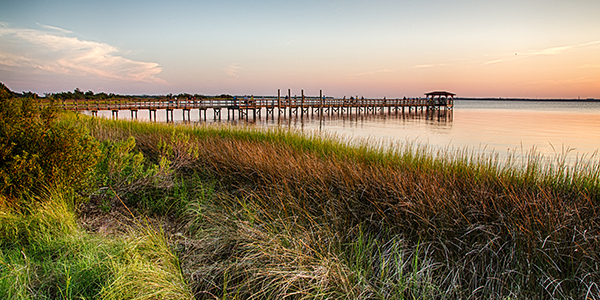
The pier on the Fort Fisher Recreation Area near Kure Beach, North Carolina with the sunsetting in the distance.
Loving Lake Norman
Although a power company built the Cowans Ford Dam across the Catawba River to generate electrical energy, the resulting lake northwest of Charlotte attracts nature lovers and fishing enthusiasts. Indeed, anglers come to Lake Norman from around the world for their chance at a record-winning catfish, crappie, largemouth bass, striped bass, and yellow and white perch. It’s the site of several fishing tournaments throughout the year. For a scenic stroll around the lake’s beautiful shoreline, follow the white blazes (red blazes for a shortcut) for this 6.2-mile moderate Lake Shore Trail hike. For a much shorter, easy stroll, ideal for children, wheelchair users, or stroller accessibility, the Dragonfly Trail is just 0.15 miles and paved. Nature displays with interactive panels teach walkers a bit about local plants and animals. It’s a great day for both hikers and anglers.
Pilot Mountain State Park
Known as “Jomeokee,” or “the Great Guide,” to the area’s early Saura (also known as the Cheraw) Indians, Pilot Mountain served as an unmistakable beacon and navigational landmark to guide Native Americans and European hunters traversing the area. Today, an extensive trail network includes the moderate but short Kid’s Track Trail, with fun activities for children along the way, and easy access to the top of Little Pinnacle, where, on clear days, you’ll capture enviable Instagram pinnacle posts. The popular Mountains-to-Sea Trail, a 1,200-mile network of footpaths from the Great Smoky Mountains in western North Carolina to the Outer Banks in the far east, passes through the Pilot Mountain State Park on three trails: Corridor, Mountain and Grindstone.
Edible Experiences
The Piedmont Triangle is home to some tasty innovations. Winston-Salem is where Krispy Kreme donuts created their most famous product — the glazed donut. Another Winston-Salem creation is Texas Pete Louisiana Hot Sauce, first released in the 1940s and still a hot seller today. Lexington is the self-proclaimed BBQ Capital of the World, with more BBQ joints per capita than any place else in the world. Cheerwine, not a wine but a cherry flavored soda, was developed in Salisbury in 1917.
Delightful Durham Dishes
Durham is home to James Beard Award–winning chef Andrea Reusing’s restaurant, appropriately named The Durham. Enjoy the evolving, fresh menu serving flavorful fare sourced primarily from North Carolina farms, fisheries and ranches. Delight in delicious dishes like Durham Paella with black rice, wild shrimp, Pamlico Sound clam and crispy pig tail.
Durham Drinks
Head to Alley Twenty Six for a night of guaranteed fun. Durham’s most awarded cocktail bar is located just two blocks from the Durham Performing Arts Center. It’s an ideal spot for an upscale snack and a refreshing gin and tonic. Mateo Bar de Tapas is a chic place for lunch and dinner with its banana pudding pie dulce, 14-inch pan paella with choices of shrimp, chorizo, sofrito, mussels and more.

Wines for all tastes
Tarheel Wine Tasting
An easy drive from Winston-Salem, and just west of Interstate 77 in Wilkes and Yadkin counties, discover the wineries on the Swan Creek Wine Trail. Four wineries will welcome you with varietal wines and blends, framed by mountain landscapes and rolling vineyards. Shadow Springs Vineyard is located in the heart of the Yadkin Valley and offers RV parking. Windsor Run Cellars Vineyard, Winery & Distillery in Hamptonville focuses on estate reds, whites, meads and fortified wines. WRC Distillery crafts spirits from their estate grapes and meads. Laurel Gray Vineyards dates back to 1773 and is committed to sustainable farming operations and producing award winning wines.
Artistry, Attractions & Exhibitions
Durham is not only a historical haven, but a starting point for an adventure. Brimming with an abundance of natural beauty, activists, artists and scholars, Durham is home to immigrant-owned galleries as well as the Durham Performing Arts Center, a former 1960s bank turned posh mid-century designed hotel. The Greensboro & Winston-Salem region is home to furniture and is the site of a massive pottery community. Discover a pottery paradise in Seagrove, strewn with artisans and handcrafted wares. Start at the North Carolina Pottery Center where the tradition continues with education and exhibitions.
West End History
The West End Historic District in downtown Winston-Salem is worth a visit. From its beginnings as a regional spa resort and an upscale community of wealthy tobacco and textile families, Winston-Salem’s West End is now a dining and shopping mecca for the city and a perfect place to explore on foot. Built around one of the first electric streetcar lines in the country, the West End boasted “Millionaires’ Row,” where the Reynolds and Hanes families kept homes bought with manufacturing fortunes. Featuring homes built between 1890 and 1930, the neighborhood is known to have the largest and most-varied concentration of front porch designs. Take time to tour the Wake Forest campus, adjacent to the 129-acre Reynolda gardens, with its postcard-worthy Waterfall Bridge.
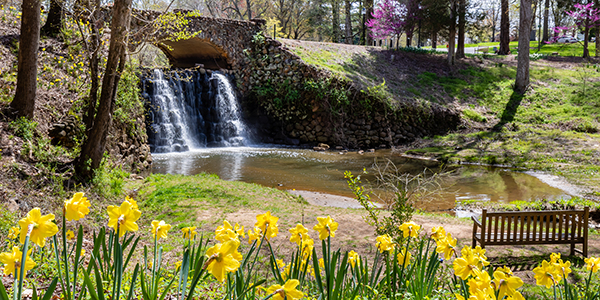
Waterfall Bridge at Reynolda Gardens in Winston-Salem, North Carolina.
Bethabara
Learn about the journey of a unique religious group by visiting Historic Bethabara Park in Winston-Salem. The first North Carolina Moravians settled here in 1753, the founding site of Forsyth County. The Park features costumed guides leading visitors through a 1788 furnished church. You can view a restored French/Indian War fort and restored medicinal garden. Greenways and path traverse the 175-acre preserve.
High Point History
To the east, the town of High Point also preserves the past. At High Point Museum & Historical Park, visitors can explore the history of region and learn how pioneers eked out an existence in the countryside. Changing exhibits provide a look at lifestyles through the years. Tour the Blacksmith Shop, as well as the clutch of Haley Houses located in the Historical Park.
Restaurants and Retailers
Occupying the former Watts and Yuille tobacco warehouses, Brightleaf Square housed some of the region’s most noted and acclaimed restaurants and retailers. Offering cutting edge fashion, rare books and specialty shops, the atmosphere is quintessential Durham – artsy and funky.
Growing Seeds
The Seeds Educational Garden in Durham teaches respect for life, the earth and others through gardening and growing food. This urban sanctuary focuses on promoting principles and practices of sustainable agriculture and organic gardening.
UNC History
Based in Chapel Hill, the University of North Carolina has enjoyed an illustrious history. Visitors can tour the campus and its museums to learn about the exploits of Tarheel teams. The Carolina Basketball Museum honors legends like Dean Smith and Michael Jordan, while the Kenan Football Stadium and Football Center burnishes a dynamic gridiron legacy.
The Great Smoky Mountains of North Carolina
Straddling the border of North Carolina and Tennessee, the Great Smoky Mountains National Park constitutes one of the most stunning natural areas in the eastern United States. Encompassing 520,000 acres, the nation’s most visited park draws over 10 million visitors a year with its diverse flora and fauna, infinite outdoor recreation and rich history.
The Natural Treasure of the East
The Smokies are a subrange of the Appalachian Mountains and have some of the highest peaks in the chain. Five types of forests within the region support more than 5,500 plants, 200 bird species, 80 varieties of amphibians and 65 kinds of mammals. Summer is the best time to come here, as temperatures in the 80s create the perfect environment for outdoor recreation. Autumn is another popular time, as stunning fall foliage draws weekend travelers and photographers. Asheville is the closest metro area and is approximately 60 miles east of the Cherokee park entrance. U.S. Route 441 offers an incredible scenic drive and will take you to the Tennessee side of the park for even more adventures.
Falling for the Smokies
North Carolina claims the largest section of the Great Smokies (270,000 acres versus 244,000 acres in Tennessee), which means you’ll have more places to roam. Hikers can follow hundreds of miles of trails, like the four-mile Appalachian Trail to the Charlies Bunion route for jaw-dropping mountain views, two-mile Joyce Kilmer Memorial Forest Loop Trail to explore old growth forests, and nine-mile Mountains-to-Sea Trail for exceptional wildlife viewing. There are more than 100 scenic waterfalls in the Smokies, from the elegant Grotto Falls to the 100-foot-high Ramsey Cascade. Several trails lead to these misty marvels, which rank among the park’s most popular sites.
Clingmans Dome
Straddling the border of Tennessee and North Carolina, the spectacular Clingmans Dome is a must-see site. At an elevation of 6,643 feet, it’s the highest mountain in the smokies and the highest point along the 2,174-mile Appalachian Trail. It’s also one of the most accessible mountain tops in the Great Smoky range. Hikers who ascend the peak are rewarded with jaw-dropping views. After a rigorous hike, unpack your snacks at the relaxing and scenic Chimney’s Picnic Area. An observation tower offers sweeping views.
Smokies Swimmers
Top fishing spots like Deep Creek and Bradley Fork are abundant in native and stocked trout. Avid anglers can also participate in numerous fishing tournaments in Cherokee. Wildlife enthusiasts will want to head to Cataloochee Valley to see elk, white-tailed deer, black bear, raccoon and turkeys. Other popular activities in the park include white-water rafting, mountain biking, horseback riding and golfing. Catching crawfish also is a popular pastime.
Colorful Cherokee
The town of Cherokee is one of the gateways to the park and is also a major center of Cherokee tribal culture. Several museums showcase native crafts and customs. Tee off at Sequoyah National Golf Club, a beautifully designed course with vistas of breathtaking mountain views. Catch musical and theatrical performances, indulge in fine dining options and test your luck at the Harrah’s Cherokee Casino Resort. Easygoing Bryson City is ready to pour you a pint at its award-winning microbrewery, while Franklin invites you to search for semi-precious stones in a handful of gem mines. For amazing souvenirs, stop by Hayesville’s Goldhagen Glass Blowing Gallery.
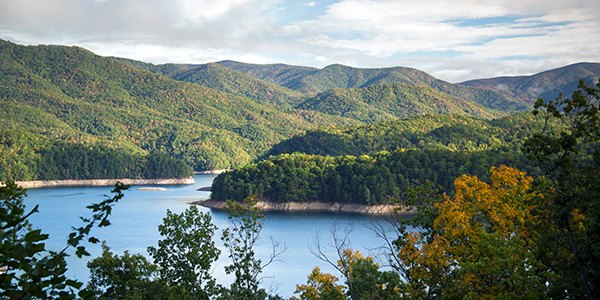
Overlooking the vast mountainous region around Fontana Lake near Bryson City, North Carolina
Fun Events
From cultural events to food festivals, you’ll find the Great Smoky Mountains offer so much more than outdoor recreation and charming towns. Enjoy traditional dancing, storytelling, and craft workshops at Cherokee Heritage Day, held once a month on Saturday. In Bryson City, fill your belly at the Annual Chili Cook-off and Car Show, or enjoy free concerts at Music in the Mountains. Celebrate folk music and dance from around the world at the Folkmoot USA International Festival, hosted by Waynesville every summer. Music lovers won’t want to miss top bands play in May at Brevard’s White Squirrel Festival, while visitors in autumn should swing by Franklin’s Pumpkinfest for their famous pumpkin roll, craft vendors and live entertainment.
Experience Native American Past
The Great Smokies are dotted with historical and cultural sites, making it easy to uncover the past while soaking up the present. The Smokies area is home to compelling human history. The town of Cherokee is named after an Eastern group of Cherokee Indians who lived there, and at their zenith they possessed more than 135,000 square miles of land within North Carolina, South Carolina, Georgia, Alabama, Tennessee, Kentucky, Virginia and West Virginia. Visitors can learn about 18th-century Cherokee life at the interactive Oconaluftee Indian Village. Cherokee historians lead visitors through a re-created village complete with traditional Cherokee dwellings and sacred ritual sites. In various work spaces, Cherokee Indians sculpt pottery and masks, weave baskets and create beadwork.
Living History
Visitors can also watch a traditional dancing show, blowgun demonstrations and various historical simulations, including the entire village gearing up for war. The illuminating Museum of the Cherokee Indian charts 13,000 years of Cherokee history from the Paleolithic, Archaic and Woodland periods to the ceremonial rituals of the Mississippian period. There’s also a unique exhibit that reveals London through the eyes of Cherokee leaders who met with King George III. The world-class exhibits utilize computer-generated animation, life-size figures and artifacts.
Farming Facts
Head to Oconaluftee’s Mountain Farm Museum to get a feel for how families lived in this region over a century ago. Boasting historic log buildings from all over the Smoky Mountains, this museum allows you to step inside a barn, smokehouse, working blacksmith shop and more. You’ll also find an impressive collection of historic buildings in Cataloochee Valley.
Gorgeous Gorge
The Nantahala Gorge is a white-water rafting destination that’s home to a clutch of nature activity centers, including the renowned Nantahala Outdoor Center, which offers rafting, mountain biking and ziplining. Along the breathtaking Cherohala Skyway (a 42-mile-long National Scenic Byway), visitors can take a cable car down to Fontana Dam — the tallest concrete dam east of the Rockies. Go fishing in Fontana Lake. Just north of Bryson City — the last vestiges of civilization before the Great Smoky Mountains National Park — Deep Creek draws hikers to its waterfall trails.
Smoky Locomotives
Tired of hiking? Take a ride on a historic train. In 1883, the Great Smoky Mountain Railroad was constructed, stretching from Knoxville, Tennessee, to Dillsboro, North Carolina, before reaching Andrews in 1890. Nowadays, the railroad is one of the region’s top tourist attractions. The distinctive steam-powered trains depart from the historic depot in Bryson City and traverse the fecund valleys and river gorges of western North Carolina. Special BBQ and Brews trains welcome passengers to enjoy slow-cooked barbecue and beers from local breweries.
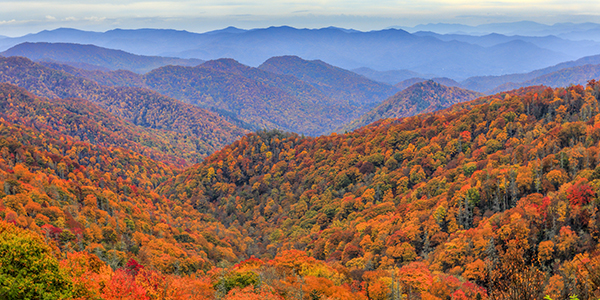
Autumn colors in Great Smoky Mountains National Park, North Carolina
Wildflowers in Bloom
Great Smoky Mountains National Park entices explorers with its world-famous wildflower preserve, boasting more than 1,500 flowering plants. Several trails lead hikers to fields that burst with colorful wildflowers. In spring, set out on the Oconaluftee River Trail, a fairly easy, three mile round trip. The riverside walk begins at Oconaluftee Visitor Center. See yellow lady’s Slipper orchids and other blossoms.
South Coast
The beaches along the South Coast of North Carolina are some of the most beautiful yet overlooked in the state. This is a water lover’s paradise with kayaking, sailing, paddleboarding, boating and fishing. There are also lighthouses, museums and carnivorous plants to keep you on your toes. Sink those toes into sandy beaches and marvel at gorgeous sunsets.
Where Life is Beachy
Oak Island has 19 miles of waving sea grass, boisterous waves and resounding ocean surf. Visit the last lighthouse built in the state on Caswell Beach before ambling over to explore Fort Caswell, a military fort built in 1825.
Topsail Island
Topsail Island is home to a sea turtle sanctuary where loggerhead, green, Ridley and leatherback turtles reside. And this is the best place on the Atlantic Coast for finding conch shells. The Missiles and More Museum tells the stories of Operation Bumble Bee, the Navy’s secret WWII guided missile program along with the history of nearly a dozen disreputable pirates. At Holden Beach, you can book a fishing charter or take a boat tour through the Intracoastal Waterway. At the beach, you can rent a kayak, jet skies, or a pontoon boat for nautical fun. Nearby, the Fisher State Recreation Area serves up six miles of beach and trails through salt marsh.
Revel in the Water
The South Coast offers exciting aquatic activities like jet skiing, hang gliding and peddle boating; even wave running, kayaking and stand-up paddle boarding, which is one of the most popular water sports in the country. Sign up for a scuba diving adventure or relax as you watch for whales.
Explore the Trails
The Carolina Beach State Park has nearly nine miles of hiking trails with forests, marshes and the 50-foot Sugarloaf sand dune just waiting to be explored. Check out Oak Toe Trail with a briny marsh overlook and views of Cape Fear River. Sand Live Oak Trail weaves among timeworn sand dunes, and Flytrap Trail edges along wetlands where carnivorous plants reside.
Exotic Plant Life
Located on three-quarters of an acre, the Stanley Rehder Carnivorous Plant Garden gives you the fascinating yet goose-bumpy experience of watching as insectivorous plants like Venus Flytrap, Pitcher Plant and Sundews lure, trap and digest their insect meals. (Close-toed shoes are suggested.)
Aquarium Fun
Close to North Carolina’s South Coast, the Crystal Coast features a slew of nautical attractions for the whole family. At Pine Knoll Shores, those traveling with kids won’t want to miss the North Carolina Aquarium, which is home to an abundance of marine life, including favorites like sharks, stingrays and sea turtles. Visitors can watch river otters play or touch a stingray. At the Loggerhead Odyssey exhibit, guests can watch turtle hatchlings take their first steps. The Living Shipwreck features three intricately recreated famous shipwreck sites. The exhibits demonstrate how sunken vessels form the nucleus of a complex marine ecosystem.
Sunken Treasure
The aquarium’s wrecks detail some of the violent maritime history of the Crystal Coast. The first is a replicated version of U-352, a German submarine sunk off the coast of Cape Lookout by the U.S. Coast Guard during World War II. The second showcases the flip-side of German U-boat activity along the North Carolina coast during the war: a replicated version the Caribsea freighter ship, torpedoed by U-158 near the Cape in 1942. And the third replication is the crown jewel of the entire collection: Queen Anne’s Revenge, Blackbeard’s infamous pirate ship. For all the terror it inspired on the high seas, its end was fairly pedestrian. It ran aground in Beaufort Inlet in 1718, likely when the crew was attempting to careen her in order to carry out hull maintenance.
One of the Best Beaches
Just east of Pine Knoll Shores at Atlantic Beach, sunbathers, surfers and sand-castle aficionados can enjoy free access to what’s been routinely selected as one of the best beaches in the country. It’s also the jumping-off point to nearby Fort Macon State Park, home to the Civil War fort of the same name. The fort is now home to a museum showcasing items like cannon emplacements and powder magazines. Cannon and musket demonstrations and guided tours are regular features. Learn about the day-to-day lives of soldiers. From Bogue Banks, your next stop should be a hop across the water to Beaufort and Harkers Island.
Pirate Wreckage
In Beaufort, don’t miss the North Carolina Maritime Museum. Here, artifacts salvaged from Queen Anne’s Revenge in 1996 are on display, including weaponry and nautical navigation equipment. Interactive displays chronicle the work done by archaeologists to locate and forensically prove the identity of the ship.
Island Time
Nearby, Harkers Island is mostly full of private homes and communities, but from here you can catch daily ferries that offer easy day trips to nearby Shackleford Banks (an undeveloped island that’s home to more than 100 wild horses — most likely descendants from abandoned shipwrecked horses) and Cape Lookout.
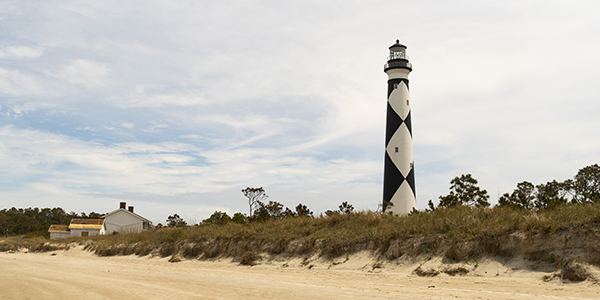
Cape Lookout Lighthouse Core Banks North Carolina Waterfront
Lookout for the Cape
Cape Lookout, located at the far eastern point of the Crystal Coast, is part of a protected National Seashore that stretches northward for 56 miles. Accessible by boat, the must-do activity here is as simple as climbing a flight of stairs to the top of Cape Lookout Lighthouse, which has beamed brightly for more than a century. Rugged campsites are available for those who don’t mind roughing it. Just remember to bring out with you all that you came in with — including garbage.
Hiking Trails
The Neusiok Trail, named after the Native American Neusiok Tribe, is the most challenging and rewarding of Crystal Coast’s nature trails. The Neusiok Trail forms part of the 900-mile Mountains-to-Sea Trail, which starts in Great Smoky Mountains National Park and spans the length of North Carolina before culminating at Jockey Ridge State Park. An immersive nature experience, the Neusiok Trail encompasses 22 miles of well marked paths (maps are also available) that pass through the distinct ecosystems that comprise Crystal Coast’s epic natural beauty: forest backed sandy beaches, salt marshes, cypress swamps, hardwood ridges, long leaf-pine savannah, and shrubby bogs.
Weetock Trail
The 11-mile Weetock Trail, named after the original Algonquian name for the White Oak River, is a loop trail, punctuated with Native American historic sites, that traverses pine flat woods, beaver ponds, creeks, and a cypress-gum swamp. A congregation of wildlife assembles near the trail’s swampier recesses, including bear, deer, and alligators. Ornithologists keen to tick off some of the state’s more unique species flock here while budding botanists find instant gratification in the form of a rich profusion of rare local orchids along the trail. With a trail head right outside the Aquarium at Pine Knolls Shore, the mile-long Roosevelt Nature Trail traverses an elevated dune ridge which affords views of marshes and maritime forests. Families love the short, half-mile Hoffman Trail, which starts just behind the Aquarium. The trail adds some gadgetry and whimsy to the outdoor experience in the form of telescopes, nature-viewing outposts, a delightful floating pontoon bridge, and captivating views of East Pond.
For More Information
VisitNC.com
800-VISITNC
VisitNC.com
Explore Asheville
828-258-6129
www.exploreasheville.com
Great Smoky Mountains
865-436-1200
www.nps.gov/grsm
North Carolina Department of Tourism
800-847-4862
www.visitnc.com
Outer Banks
877-629-4386
www.outerbanks.org
South Coast North Carolina
800-VISITNC
www.visitnc.com/coast
